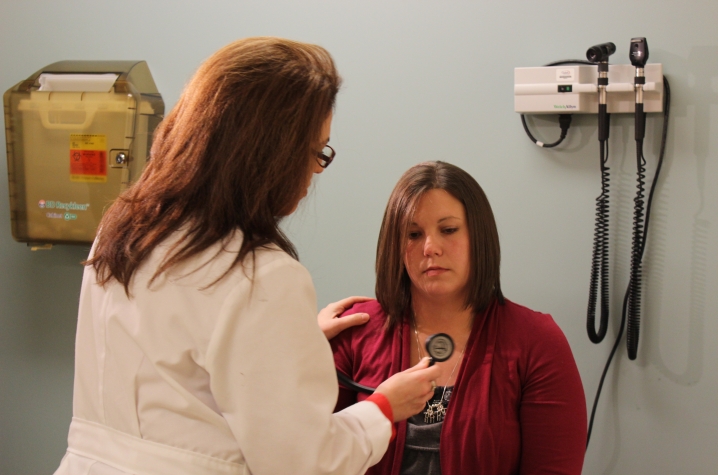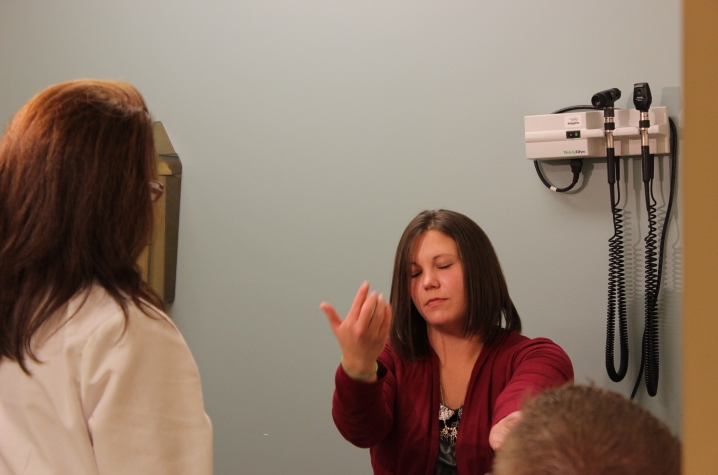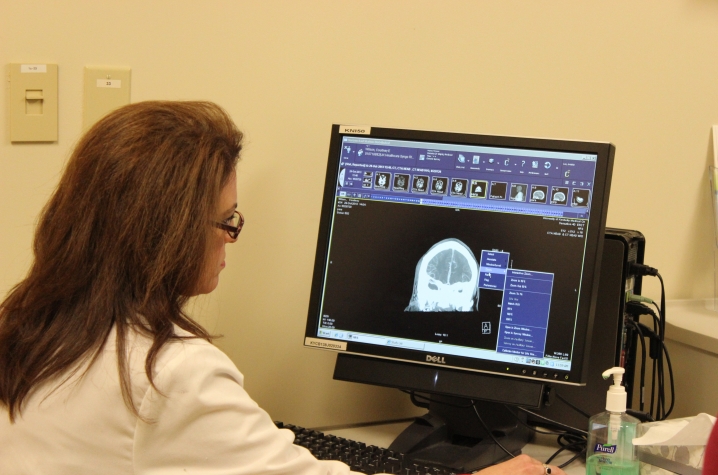Quick Action by UK HealthCare Multidisciplinary Team Saves Life of Young Mother
LEXINGTON, Ky. (Jan. 7, 2014) -- By all accounts, Courtney Wilson is lucky to be celebrating another new year. The 30-year-old preschool teacher's assistant from Russell County awoke one morning "feeling awful," she says. She dropped her 2-year-old off at daycare and took her 5-year-old to school, then popped into the school nurse's office for advice.
"All I could tell her was that I felt really bad and that my balance was off," said Courtney. "The nurse drove me to the Emergency Room right away."
At Russell County Hospital, emergency room doctors examined her carefully but could find no other symptoms to explain Courtney's troubles. They consulted with Dr. Jessica Lee, director of UK HealthCare’s Stroke Center, who advised them to administer the clot-buster drug called TPA and send Courtney immediately to UK Chandler Hospital.
Lee and her team from UK's Kentucky Neuroscience Institute were similarly confused by Courtney's mysterious lack of neurological deficits. But Comprehensive Stroke Centers like the one at UK HealthCare follow specific procedures when evaluating possible stroke patients. So, as part of UK's routine screening process, Lee ordered a CT Angiogram, which provides doctors with images of the vessels that supply oxygen-rich blood to the brain.
"When we pulled her scan up on the screen, it was shocking news," Lee says. "We were stunned."
Courtney had a thrombus -- a blood clot -- in what's called "The Artery of Life." This artery is the superhighway of arteries, serving areas of the brain that control heartbeat and breathing. Courtney was on the precipice of a massive stroke.
"I literally ran to her hospital room," remembers Lee, "and sure enough, she was deteriorating before my eyes. We absolutely scrambled from there."
Lee told Courtney's distraught husband Paul what was happening to Courtney, and assured him that "there would be a lot of running in and out of the room, but it was all in Courtney's best interest." She then assembled a team to save Courtney's life.
UK is fortunate to have a "dream team" trained to handle emergencies like this one. Dr. Abdulnasser Alhajeri is an interventional neuroradiologist -- one of only about 300 in the U.S. -- and Dr. Justin Fraser is an endovascular neurosurgeon. Both doctors are able to navigate tools such as tiny catheters, wires and other devices through blood vessels to diagnose and treat illnesses of the spinal cord and brain -- also known as the central nervous system. Because this requires only a tiny incision in the groin instead of the larger incision necessary for open surgery, hospital stays and recovery times are faster, complications are less likely, and patients can return home to their families more quickly.
But, in wha tLee describes as "the perfect storm," both Drs. Fraser and Alhajeri were in other operating rooms on separate cases.
Time for Plan B.
Lee assembled a second surgical team to perform the preliminary phases of the procedure. "I didn't even wait for transport to come get Courtney," says Lee. "Our Stroke Unit senior staff and I took her to the surgical suite ourselves."
Then, as if choreographed, Dr. Alhajeri stepped from one room to the next and began to work on Courtney. Using high-tech precision imaging to watch its progress, Alhajeri positioned the catheter in Courtney's brain, attached a large syringe-like device and sucked the clot out, reopening the vessel in just 15 minutes. "It was like watching the pneumatic tube at the bank drive-in," said Dr. Lee. "Whoosh! It was gone."
"Courtney is a lucky young woman for many reasons," says Alhajeri. "The doctor in the Russell County Hospital ER had the foresight to call our stroke team despite Courtney's lack of major symptoms. The TPA they gave her delayed her decline and bought us some time to perform the thrombectomy."
"She is also fortunate that UK has the resources to treat her. The next closest center that might have been able to treat her was an additional 90 minutes away. She didn't have 90 minutes to spare."
Since her illness has an 80-90 percent mortality rate, the mere fact that Courtney is alive today is a wonder. But the best part?
"The very few who survive this devastating event typically are left with substantial impairments, such as vision problems, the inability to speak or swallow, or complete paralysis," says Lee. "But Courtney's only residual deficit is some double vision on her far left gaze. We're truly thrilled with her outcome."
As is her family.
"All I could think about was how would I tell my boys that they were going to grow up without their mother," Paul says. "Courtney and I have been together 11 years, and married for 7. The boys are totally connected to her. I couldn't imagine life without her. Thank heaven I don't have to."
Since Courtney's close call, the family has reprioritized. They spend a lot of time together, focusing on the little things.
"I could just sit here and watch the boys play for hours," says Courtney. "Even when they fuss, I like it now, because I might not have had the chance to watch them grow up and do all the things boys do."
Paul is also grateful to the many friends who supported the family through this terrifying time. "The unknown is the scariest," he says. "But I had friends and even total strangers calling my cell phone to tell me they were praying for Courtney. It was comforting to me and made the scary part a little less scary."
Paul says it best of all: "Enjoy every minute, because you never know when you'll take your last breath. Faith and family is all you really need."
"Well, and some really good doctors," he finishes with a smile and a tear.
Media Contact: Laura Dawahare, 859-257-5307 or laura.dawahare@uky.edu







